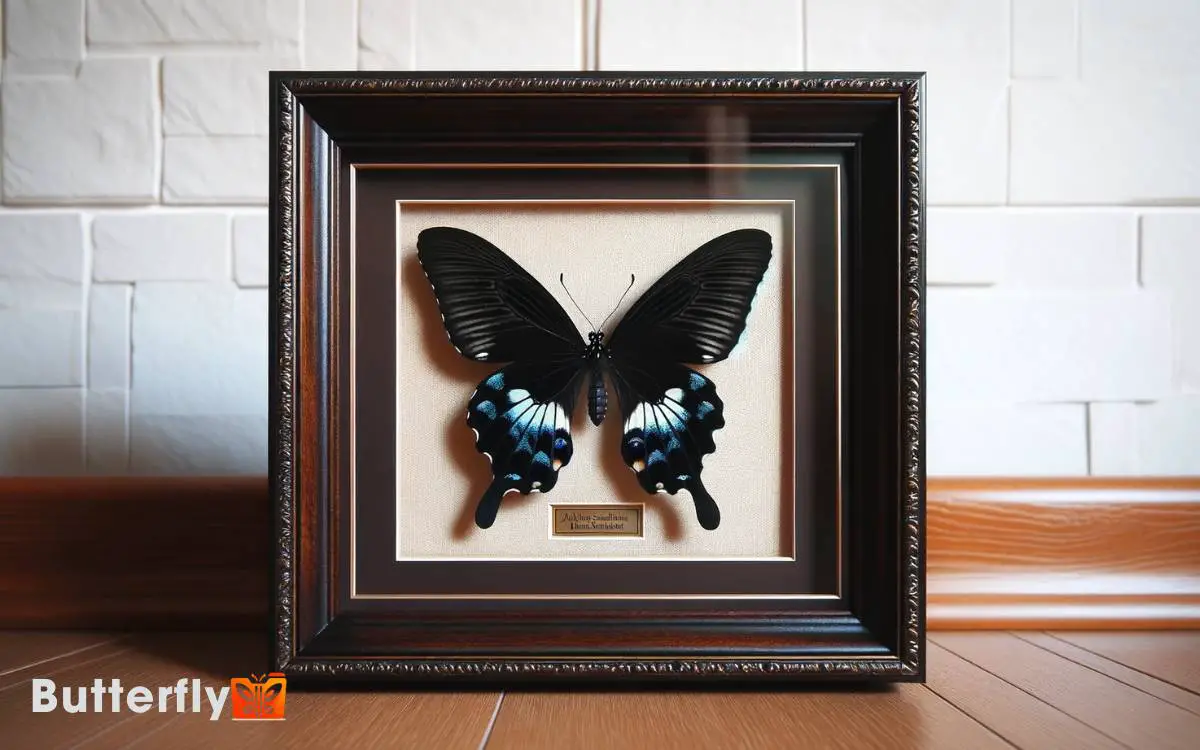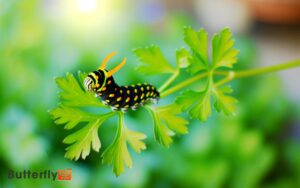Alpine Black Swallowtail Butterfly Framed: Exquisite Display
Framing the Alpine Black Swallowtail Butterfly (Papilio maackii) necessitates expert precision. This butterfly, known for its adaptability to cold climates, undergoes various stages from egg to adult.
Capturing techniques include netting and immediate preservation with ethyl acetate, followed by careful pinning for study.
Historical data on Papilio maackii aids in evolutionary and ecological research, emphasizing its importance in scientific collections. Discover more about its artistic preservation.

Key Takeaways
The Alpine Black Swallowtail
The Alpine Black Swallowtail, scientifically known as Papilio maackii, inhabits high-altitude regions where it thrives in cold, mountainous environments. This butterfly species demonstrates remarkable resilience to low temperatures, allowing it to flourish in alpine ecosystems.
The striking iridescent blue-green wings, bordered by black, serve not only aesthetic purposes but also play a role in thermoregulation. Its lifecycle includes four distinct stages: egg, larva, pupa, and adult, each adapted to survive harsh climatic conditions.
Adults primarily feed on nectar from alpine flora, contributing to pollination. The species’ distribution spans from the Himalayas to the Russian Far East, indicating its adaptability.
Papilio maackii’s survival strategies exemplify nature’s ingenuity, resonating with those who seek freedom in rugged, untamed landscapes.
Artistic Framing Techniques
Framing the Alpine Black Swallowtail butterfly requires meticulous attention to detail and a mastery of artistic techniques to preserve its delicate structure and vibrant colors. Photographers and illustrators must carefully consider lighting, composition, and depth of field to highlight the intricate wing patterns and iridescent hues. Understanding the anise swallowtail butterfly life cycle provides valuable insight into the development stages, enabling artists to depict these butterflies with greater accuracy. By combining scientific knowledge with creative expression, one can capture the essence of this remarkable species in stunning detail.
The process starts with a precise mounting procedure, utilizing entomological pins to secure the specimen without damaging its wings.
A non-acidic, archival-quality mat board is essential to prevent deterioration. UV-protective glass shields the butterfly from light damage, ensuring longevity.
The frame should be crafted from sustainable materials, aligning with ethical practices. Additionally, a dust-sealed enclosure keeps the display pristine.
The final step involves arranging the butterfly in a lifelike position, enhancing its natural beauty while maintaining structural integrity. Each step demands precision and care, allowing the butterfly’s elegance to captivate viewers.
Historical Significance
Since their discovery in the early 19th century, Alpine Black Swallowtail butterflies have captivated both scientists and collectors, serving as a key species in studies of alpine ecosystems and evolutionary biology.
These butterflies have provided invaluable data on:
- Adaptation mechanisms in high-altitude environments
- Migration patterns influenced by climatic changes
- Genetic diversity within isolated populations
- Symbiotic relationships with alpine flora
Researchers have leveraged these insights to understand broader ecological dynamics and evolutionary processes. The Alpine Black Swallowtail’s prominence in scientific literature underscores its importance.
Their enduring appeal also reflects humanity’s intrinsic fascination with nature’s wonders.
Through rigorous field studies and detailed observations, these butterflies have contributed significantly to the scientific community’s knowledge, resonating deeply with those who value exploration and discovery.
Collecting and Preservation
Collectors meticulously prepare and preserve Alpine Black Swallowtail butterflies to maintain specimen integrity and guarantee long-term study viability.
They capture specimens using fine mesh nets, ensuring minimal damage to delicate wings. Immediate euthanasia is performed with ethyl acetate, preserving the butterfly in its most pristine state.
Specimens are then placed in airtight containers with desiccants to prevent moisture damage. Pinning follows, where butterflies are carefully positioned on spreading boards to display their wings fully.
This step is essential for accurate morphological studies. Labels detailing collection location, date, and environmental conditions are affixed.
Lastly, specimens undergo a drying process in well-ventilated, dark environments to prevent color fading. Such meticulous methods make sure that these butterflies remain valuable for scientific research and educational purposes.
Display and Care Tips
Properly displaying and caring for Alpine Black Swallowtail butterflies involves using UV-protective glass and climate-controlled environments to preserve their vibrant colors and intricate details. Ensuring these conditions prevents fading and structural damage.
Display frames should be airtight to maintain internal humidity and temperature.
- UV-protective glass: Shields the specimen from harmful ultraviolet rays.
- Climate control: Maintains consistent temperature and humidity, essential for longevity.
- Airtight frames: Prevents dust, pests, and fluctuating humidity from entering.
- Proper lighting: Use ambient, indirect light to avoid heat buildup.
These meticulous steps ensure the preserved butterflies remain pristine, offering enthusiasts the freedom to admire their beauty without degradation concerns. Employing scientific methods guarantees the preservation and appreciation of these remarkable specimens for years to come.
Conclusion
The Alpine Black Swallowtail, a marvel of nature, captivates both the casual observer and the dedicated lepidopterist. Yet, how it will be framed can transform its allure into a timeless piece of art.
Will you employ traditional methods or innovate with contemporary techniques?
As you ponder the best approaches for preservation and display, remember that the choices you make not only safeguard its delicate beauty but also honor its historical and ecological significance.
What’ll your decision reveal?






